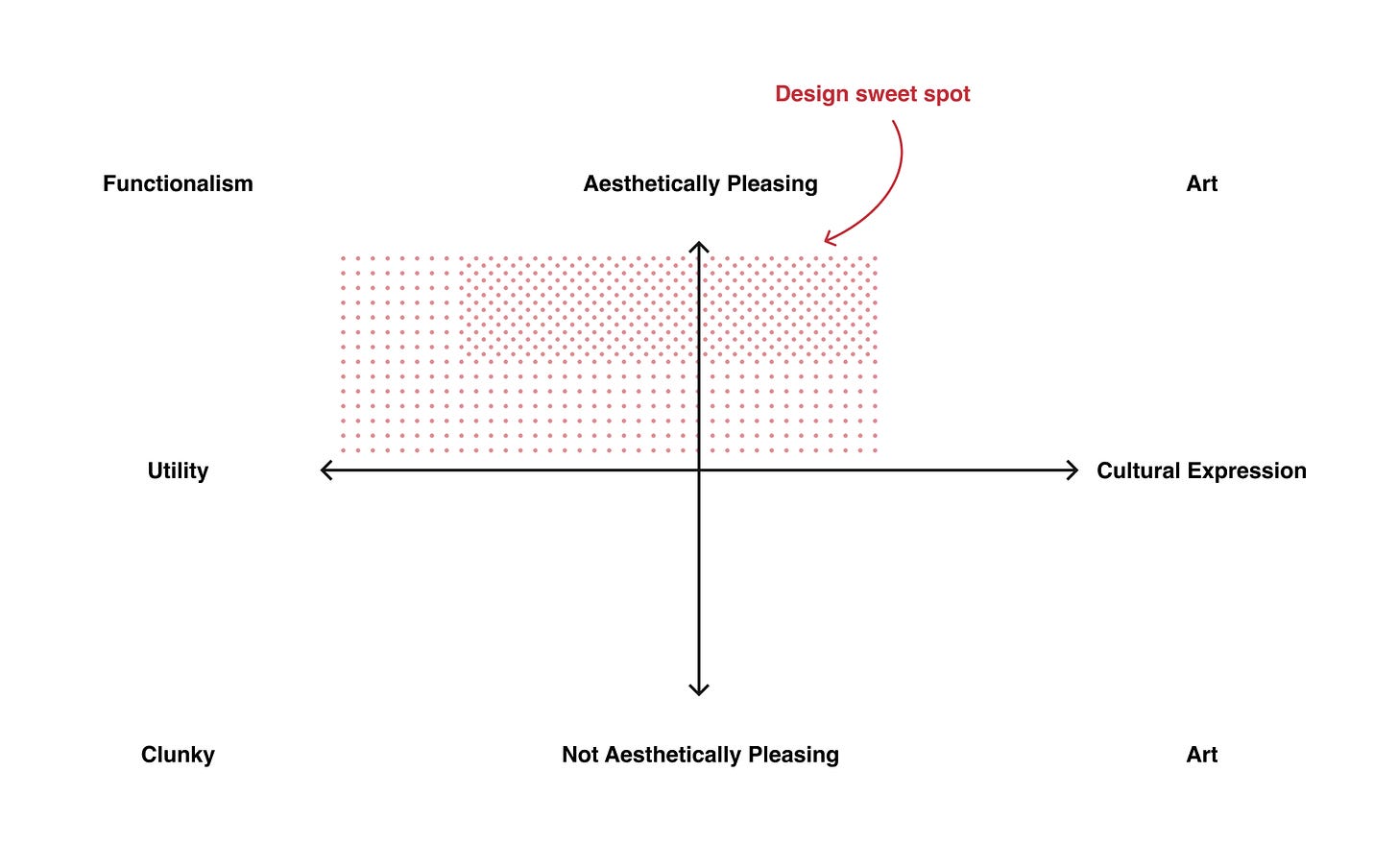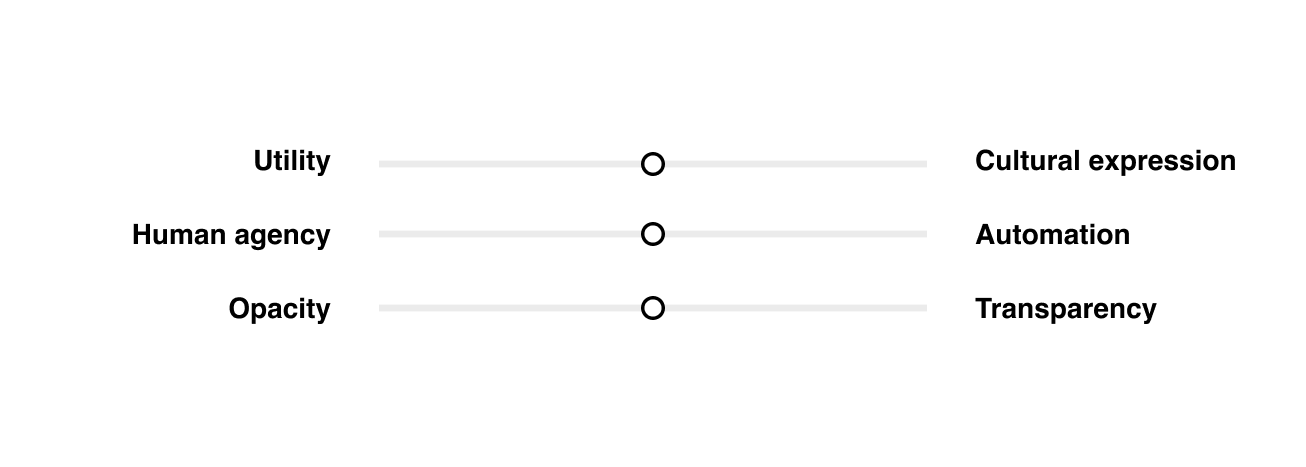Building with purpose: Navigating the Design tensions that matter
Practical frameworks for balancing functionality, cultural expression, and user trust.
Every great product walks a fine line. Solving problems while sparking emotion. Being functional, but also striving for elegance. And today, product teams face these tensions at higher stakes and faster cycles than ever before.
In this article, I explore the design trade-offs that matter most — and how startups can navigate them with intention.
Design tension at play
Functionalism & Aesthetics
At the core of every great product lies a tension between functionalism and aesthetics. Functionalism demands that design serves a purpose — that every detail earns its place. It’s about clarity, precision, and stripping away the unnecessary.
Aesthetics, by contrast, speaks to emotion. It’s the color, shape, texture, and style that make people feel something. Aesthetics gives a product its character. It connects with culture, stirs curiosity, and creates delight beyond pure function.
These forces don’t cancel each other out. They coexist, shaping how users experience and value what we create. The real challenge is how we choose to balance them — deliberately, not by accident.
But to find the attributes of product successes, we need to go one level deeper:
Utility vs. Cultural Expression
Functionalism is a philosophy; utility is how we measure its success. Utility is about solving problems — delivering clear, measurable value that meets user needs. It’s about performance, precision, and purpose.
Aesthetics, on the other hand, is about how a product makes people feel. It’s tied to cultural and artistic expression — the shapes, colors, textures, and styles that move people emotionally. Great aesthetics can inspire, challenge, or comfort. It pushes products beyond pure function into the realm of meaning and connection.
We see this tension whenever a company releases something new that blends tech and art. When Airbnb launches 3D icons, Apple unveils Liquid Glass, or Perplexity introduces AI-generated illustrations — they’re not solving problems. They’re responding to a cultural moment, using what’s now technically possible to create new forms of cultural expression.
This is the ongoing tension between utility and cultural expression. Both matter. The challenge is deciding how much weight to give each in your product — and why.
New design tension at play
The question in our products is no longer just what is designed (utility, expression) but who makes decisions and how much control they have.
Human Agency vs. Automation
This tension asks: Who makes the decisions — the user or the system?
Human agency puts users in control. The system becomes a tool to support creativity, judgment, and nuance — amplifying human intent rather than replacing it.
Automation shifts decisions to the system. The value lies in speed, efficiency, and reduced cognitive load. Automation helps users achieve outcomes faster and with less effort.
Cursor or Tesla Autopilot center their value on Automation to gain efficiency and reduced mental effort.
At Feedly Threat Intelligence, we’ve chosen to prioritize human agency. Our AI provides insights with clear logic and causation, so analysts stay in charge. We believe judgment belongs to the human, not the machine.
Ask yourself: Where on this spectrum should your product sit? What do your users value most: control or convenience?
Transparency vs. opacity of intent
This tension asks: Do users understand why the product behaves the way it does — especially when AI is involved?
Transparency means exposing the logic, signals, or decisions behind a feature. It builds trust by helping users see the “why” behind the “what.” Opacity, on the other hand, hides these inner workings. Sometimes this simplifies the experience; other times, it leaves users guessing.
Think of Midjourney, where image generation feels like magic but gives little insight into how results are shaped. Compare that to systems that surface their reasoning — like models that display system messages, confidence scores, or source links.
Ask yourself: How much do your users need to see? And what happens to trust if you hide too much?
Conclusion
Design is always a balancing act — between utility and expression, agency and automation, transparency and opacity. These tensions aren’t problems to solve once. They are forces to navigate, again and again, as technology evolves and culture shifts.
What matters is intentionality. Where you choose to place your product on these spectrums should reflect your values and your users’ needs — not just what’s possible, but what’s meaningful.
So ask yourself:
What tension is shaping my product right now?
How will you steer through it in the upcoming months?
What would it mean to move deliberately, not just react?
Design isn’t about fixing a point on a map. It’s about setting a direction, staying aware of the forces at play, and adjusting your course with purpose.
This part of the newsletter is a place for you to access
the most valuable links I’ve recently found.
Little extra
I wanted to share an inspiring video this time. Add this to you watchlist right now and thank me later.
“If you want to live an asymmetric life, Do hard things. Do your things. Do it for decades. Write your story.”
Thank you for reading
This newsletter is my attempt to deliver exclusive frameworks and actionable insights for entrepreneurs and designer to harness design as their strategic advantage.
I’ve been slower to post recently as I’ve stepped into a Staff Product Designer & Manager position now. And we have very interesting challenges (I’m hiring a Senior Product Designer – Full remote friendly) so thank you for being part of this journey.
Remember, this is your journey as much as it is mine. If you feel this isn't what you're looking for at any point, please feel free to opt out–there will be no hard feelings.
If you have any suggestions on how I can improve the format, reply to this email with your feedback, and I will personally reply to all emails.
Take care,



